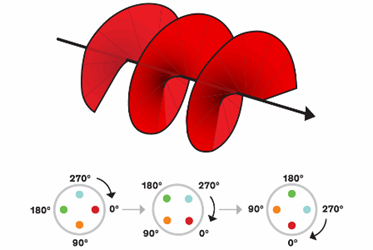Twisting Light Using Two Spatial Degrees Of Freedom Could Solve Spectrum Crunch
By Jof Enriquez,
Follow me on Twitter @jofenriq

Researchers have demonstrated a proof-of-concept technique that twists a light beam into more than one hundred spatial modes to carry more information than what is possible through current telecommunications technologies.
Certain beams of light possess orbital angular momentum (OAM), which allows these beams to be overlaid, one on top of another, to carry a theoretically unlimited number of different data streams at the same time, according to an IEEE Spectrum article. Researchers, therefore, consider OAM waves as a potential solution to an impending spectrum crisis.
In theory, it's possible to overlay these beams simultaneously, and to control their azimuthal degrees of freedom to create different spatial modes. Because of the property of orthogonality, they won't interfere with each other, making it possible to create an infinite number of spatial modes carrying huge amounts of data.
In reality, however, there are limitations in the number of modes that can be produced. In fact, today’s optical networks use just one spatial mode to carry information, compounding the bandwidth and spectrum crunch.
Researchers led by Andrew Forbes, a professor at the University of Witwatersrand, South Africa, claim to have overcome this challenge by combining a new spatial multiplexing approach with wavelength division multiplexing (WDM) using both the azimuthal degrees of freedom, as well as another variable called the radial degrees of freedom, in order to significantly increase bandwidth capacity.
To achieve this, they used a device called a spatial light modulator to shape Laguerre Gaussian (LG) beams (where modes have the two degrees of freedom) into multiple other modes, and another to reverse the process on the receiving end.
“We created 35 spatial modes encoded in three different wavelengths, producing 105 total modes,” said Carmelo Rosales-Guzmán, research fellow and first author of the research paper, in a news release. “Our new method might serve as the basis for future communication technologies.”
The modes created were used as information carriers to transmit a grayscale and a color image in a proof-of-concept free space link.
“In this demonstration, sending a 10,000-pixel image took five to seven minutes,” said Rosales-Guzmán. “However we could increase that speed by sending two or four pixels at the same time or by using many more wavelengths.”
Real-world free space linking presents challenges, however, as their technique, to be deemed practical, must demonstrate successful communication between devices, between buildings, or even from satellites.
“We are working with a company in South Africa that already makes a device that has the ability to use different spatial modes for free space communication,” said Rosales-Guzmán. “We are interested in trying to increase the bandwidth of their device to four times what it is capable of now.”
"Our approach can be implemented in both, free space and optical fibres, facilitating studies towards high bit rate next generation networks," wrote the researchers of the study published in Scientific Reports.
A related presentation is scheduled on Nov. 3, 2016 at the upcoming OSA (The Optical Society) Laser Congress in Boston, Mass.
